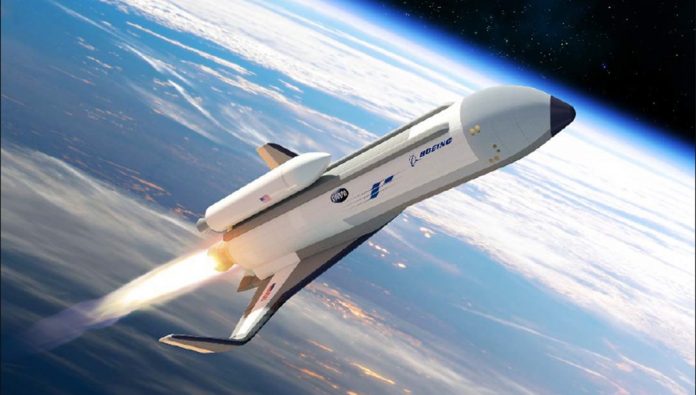

DARPA has selected the Boeing Company to complete advanced design work for the Agency’s Experimental Spaceplane (XS-1) program, which aims to build and fly the first of an entirely new class of hypersonic aircraft that would provide short-notice, low-cost access to space. The new space plane will be able to rapidly deploy satellites and payloads to low Earth orbit in days, rather than months or years of preparation currently needed to get a single satellite on orbit. Such capabilities will enable the Pentagon to replace critical capabilities compromised by catastrophic damage or hostile action from ground-based or space-based weapons. Such weapons were tested by China and Russia.
Unlike the X-37 space plane launched by satellite launchers on extended missions in space that span over a year, but lands on a runway, the future XS-1 envisions a fully reusable suborbital unmanned vehicle that will be able to take off and land like an aircraft. Roughly the size of a business jet, it would take off vertically like a rocket and fly to hypersonic speeds. The vehicle would be launched with no external boosters, powered solely by self-contained cryogenic propellants. Upon reaching a high suborbital altitude, the booster would release an expendable upper stage able to deploy a 3,000-pound satellite to polar orbit. The reusable first stage would then bank and return to Earth, landing horizontally like an aircraft, and be prepared for the next flight, potentially within hours.
“The XS-1 would be neither a traditional airplane nor a conventional launch vehicle but rather a combination of the two, with the goal of lowering launch costs by a factor of ten and replacing today’s frustratingly long wait time with a launch on demand,” said Jess Sponable, DARPA program manager. “We’re very pleased with Boeing’s progress on the XS-1 through Phase 1 of the program and look forward to continuing our close collaboration in this newly funded progression to Phases 2 and 3—fabrication and flight.”
Once delivered for testing, XS-1 will perform a series of flight tests demonstrating the capability to fire the engine 10 times in 10 days. This test is scheduled to begin in 2019. Beginning the actual test flights in 2020 XS-1 will perform 12-15 shakedown flights then perform the test’s goal flying 10 missions on 10 days at speeds as high as Mach 5-10. its final test flight XS-1 will carry an upper-stage payload delivery system that will deliver a satellite weighing 900-3,000 lbs into low earth orbit.
If successful, the program could help enable a commercial service in the future that could operate with recurring costs of as little as $5 million or less per launch, including the cost of an expendable upper stage, assuming a recurring flight rate of at least ten flights per year—a small fraction of the cost of launch systems the U.S. military currently uses for similarly sized payloads.
Some of the technologies used in the XS-1 derive from space vehicles – the advanced, lightweight composite cryogenic propellant tanks are designed to hold liquid oxygen and liquid hydrogen propellants. The propulsion system is an Aerojet Rocketdyne AR-22 engine, a version of the legacy Space Shuttle main engine (SSME). On the other hand, the space plane will use easily accessible subsystem components configured as line replaceable units, similar to the systems used in repairing and maintaining military planes. To endure the high temperature of reentry, hybrid composite-metallic wings and control surfaces are used, able to withstand the physical stresses of suborbital hypersonic flight and temperatures of more than 2,000F. Automated flight-termination and other technologies for autonomous flight and operations, including some developed by DARPA’s Airborne Launch Assist Space Access (ALASA) program.
DARPA intends to release selected data from the XS-1 to companies interested to commercialize this capability. “We’re delighted to see this truly futuristic capability coming closer to reality,” said Brad Tousley, director of DARPA’s Tactical Technology Office (TTO), which oversees XS-1. “Demonstration of aircraft-like, on-demand and routine access to space is important for meeting critical Defense Department needs and could help open the door to a range of next-generation commercial opportunities.”
If successful, the program could help enable a commercial service in the future that could operate with recurring costs of as little as $5 million or less per launch, including the cost of an expendable upper stage, assuming a recurring flight rate of at least ten flights per year—a small fraction of the cost of launch systems the U.S. military currently uses for similarly sized payloads.



















